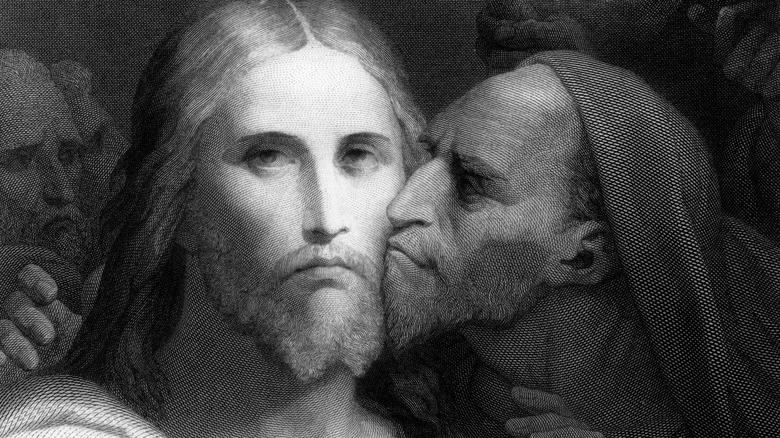The Judas Theory In The Bible That Would Change Everything
When you hear the name "Judas," it's probably not being used in a nice way. Often, people use it as a noun for someone who's betrayed someone. And for good reason. One of the Twelve Apostles was named Judas Iscariot. He is seen in the famous painting "The Last Supper" seated fourth from left in the artwork, which makes him three people left from Jesus. But he wasn't an apostle for long — Judas took his own life after betraying Jesus by revealing his location, identifying him with a kiss. He committed the act for 30 pieces of silver from several Jewish priests. In the Bible, Matthew 27:3 explains the aftermath. After realizing that his actions led to the condemnation of Jesus, Judas immediately regretted his actions. He realized what he had done and repented by trying to return the money to the same priests. But the weight of his guilt was too much to bear, and he died by suicide.
He was later replaced by Saint Matthias. That's how the story goes and why Judas is considered an unfavorable person. But there's also information that might change the tale surrounding the disgraced apostle and how history remembers him.
Does this text vindicate Judas?
More than a decade ago, a new theory revealed a story of Judas that could transform how people remember the famous tale. In 2006, the National Geographic Society revealed an ancient papyrus called the Gospel of Judas. This text, which was translated and restored, was written in the second century and may reveal that Judas did not betray Jesus. In fact, he might have been acting under Jesus' orders so he could reach heaven.
Speaking to NPR, author and researcher Herb Krosney — who penned "The Lost Gospel," which dives into the discovery of the Gospel of Judas and what it means — said Judas was Jesus' closest friend and favorite disciple. The document apparently shows that Jesus trusted Judas and had a lot of faith in him. He supposedly asked Judas to sacrifice himself for a great mission, which is interpreted as Jesus asking Judas to betray him. When the day came, Judas planted the kiss of death on Jesus, who was identified and arrested.
Many stand conflicted on this theory, which somewhat vindicates Judas. No one knows the true author of the gospel, but it does present another view of the famous story. However, some contend that the tale we already know is the only truth. "I don't think it changes anything about the truth of the Christian faith," Reverend John Pritchard told The Guardian. "There has long been a theory that Judas wanted to flush Jesus out, to declare a rebellion and drive the Romans out and killed himself when he realized he had got it wrong, but we don't know that and neither did whoever wrote this document decades after the event. This is not something to put your faith on."
Insight into Gnosticism
Other Christian scholars suggest that the gospel is likely the work of the Gnostics, who claimed to have a direct connection with the divine and secret knowledge of Christ and the universe. They were in opposition to the early establishers of Christian doctrine, the Church Fathers, who declared them heretical (there's a reason the Gnostic Gospels aren't in the Bible). "The document is of interest for the ideas of the gnostics but it almost certainly adds nothing to our understanding of what happened 150 years before it was written," professor Geza Vermes of Oxford University told The Guardian.
Still, the gospel could provide greater insight into the time period from which it came. From the first to the third century, Christianity did not have a central authority and encapsulated various viewpoints, including Gnosticism. "I expect this gospel to be important mainly for the deeper insight it will give scholars into the thoughts and beliefs of certain Christians in the second century of the Christian era, namely the Gnostics," Stephen Emmel, a Coptic studies professor at the University of Münster, told National Geographic.


